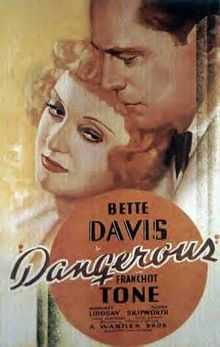Dangerous (film)
| Dangerous | |
|---|---|
 Theatrical release poster | |
| Directed by | Alfred E. Green |
| Produced by |
Harry Joe Brown Hal B. Wallis Jack L. Warner |
| Written by | Laird Doyle |
| Starring |
Bette Davis Franchot Tone Margaret Lindsay |
| Music by |
Ray Heindorf Heinz Roemheld |
| Cinematography | Ernest Haller |
| Editing by | Thomas Richards |
| Distributed by | Warner Bros. |
| Release dates | December 25, 1935 |
| Running time | 79 minutes |
| Country | United States |
| Language | English |
Dangerous is a 1935 American drama film directed by Alfred E. Green and starring Bette Davis in her first Oscar-winning role. The screenplay by Laird Doyle is based on his story Hard Luck Dame.
Plot synopsis
Don Bellows (Franchot Tone), a prominent New York architect, is engaged to the beautiful and wealthy Gail Armitage (Margaret Lindsay) when he meets down-and-out Joyce Heath (Bette Davis), who was once the most promising young actress on Broadway. Don feels deeply indebted to Joyce because her performance as Juliet inspired him to become an architect.
While rehabilitating her, Don falls in love with the tempestuous actress. Joyce, convinced she destroys anything and anyone she touches, warns him she is a jinx. Compelled to save her, Don breaks his engagement to Gail and risks his fortune to back the actress in a Broadway show. Before opening night, he insists they marry, but Joyce resists his proposal, hiding the fact she is married to Gordon Heath (John Eldredge), an ineffectual but devoted man who was financially ruined by their marriage.
Joyce goes to Gordon and begs him for a divorce. When he refuses, she causes an automobile accident that cripples him for life. Her own injuries keep her from opening in the show, which fails. Don is ruined, and when he learns that Joyce has deceived him, he accuses her of being a completely selfish woman, her only true jinx.
Joyce briefly considers suicide, but eventually sees the truth in Don's accusation. She re-opens the show and, although she truly loves Don, sends him away to marry Gail. The show is a success, and Joyce, now dedicated to a responsible life, goes to visit Gordon and salvage her marriage.
Cast
- Bette Davis as Joyce Heath
- Franchot Tone as Don Bellows
- Margaret Lindsay as Gail Armitage
- Alison Skipworth as Mrs. Williams
- John Eldredge as Gordon Heath
- Dick Foran as Teddy
- Walter Walker as Roger Farnsworth
- Richard Carle as Pitt Hanley
- George Irving as Charles Melton
- Pierre Watkin as George Sheffield
- Douglas Wood as Elmont
- William B. Davidson as Reed Walsh (as William Davidson)
Production notes
Bette Davis initially turned down the script, but Warner Bros. studio production chief Hal B. Wallis convinced her she could make something special out of the character, who had been inspired by one of Davis' idols, actress Jeanne Eagels.[1] She was determined to look like an actress on the skids, and insisted Orry-Kelly design costumes appropriate for a woman who had seen better days. It was for this film Perc Westmore styled her hair in the bob cut she would favor for the rest of her life.[2]

Three songs by Harry Warren - "Forty-Second Street," "The Little Things You Used to Do," and "Sweet and Slow" - are heard on the soundtrack. The other song was "Bridal Chorus" by Richard Wagner.
In 1941, the film was remade as Singapore Woman with Brenda Marshall in the lead role. It coincidentally utilized some of the sets from The Letter, the 1940 film starring Davis.[3]
Davis won the Academy Award for Best Actress for her performance, but always felt it was a consolation prize for not having been nominated for Of Human Bondage the previous year.[4] In 2002, Steven Spielberg anonymously bought the Oscar Davis had won at auction at Sotheby's and returned it to the Academy of Motion Picture Arts and Sciences. The statuette had been part of the memorabilia displayed by the Planet Hollywood restaurant chain.
Critical reception
The New York Times wrote, "That Bette Davis has been unable to match the grim standard she set as Mildred in Of Human Bondage is not to her discredit. In Dangerous, she tries again. Except for a few sequences where the tension is convincing as well as deadly she fails . . . Say this for Miss Davis: she seldom lets down."[5]
Variety wrote, "Laird's dialog is adult, intelligent and has a rhythmic beat. Davis' performance is fine on the whole, despite a few imperfect moments. When called upon to reach an intense dramatic pitch without hysterics, Davis is capable of turning the trick. Yet there are moments in Dangerous when a lighter acting mood would be opportune."[6]
References
- ↑ 1.0 1.1 Dangerous at Turner Classic Movies
- ↑ Mother Goddam by Whitney Stine, with a running commentary by Bette Davis, Hawthorn Books, 1974, pp. 70-71 (ISBN 0-8015-5184-6)
- ↑ Mother Goddam, p. 73
- ↑ The Life of Bette Davis by Charles Higham, Macmillan Publishing Company (1981), p. 76 (ISBN 0-02-551500-4)
- ↑ New York Times review
- ↑ Variety review
External links
| Wikimedia Commons has media related to Dangerous (film). |
- Dangerous at the Internet Movie Database
- Dangerous at allmovie
- Dangerous (film) at the TCM Movie Database